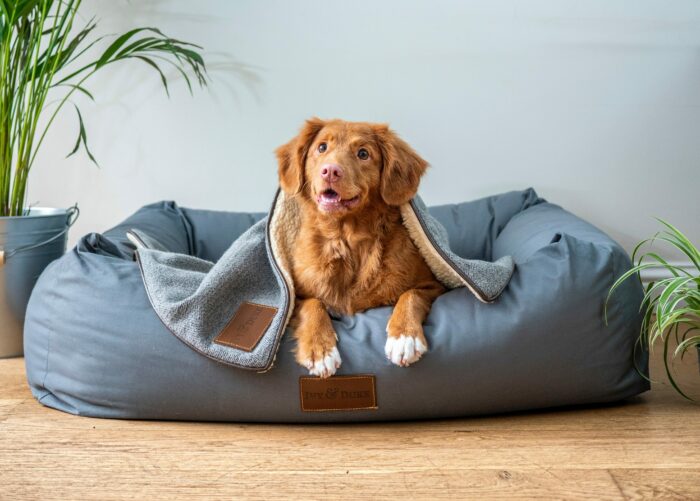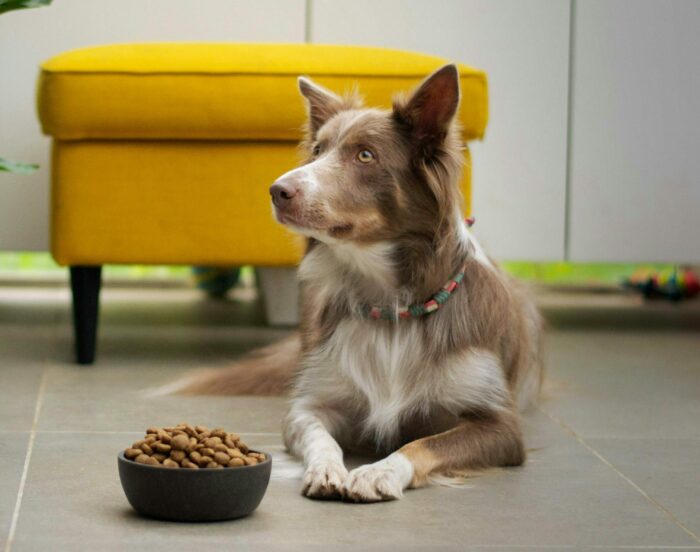As the winter season blankets the world in frost and snow, our canine companions face challenges distinct from our own. Unlike people, they can’t just put on warm clothes. This means we, as dog owners, need to help them. Winter weather can really affect your dog’s health, especially older dogs – so keeping them warm is very important.
- Insulated shelters protect dogs from winter elements.
- Limit outdoor time when it's below 32°F.
- Inside, keep temperatures in the mid-60s for comfort.
- Adequate clothing helps dogs stay warm outside.
- Apply paw balm to protect dogs from harmful substances.
Dogs can get hypothermia and frostbite in the cold, just like humans. A study shows that cold weather is a big risk for pets, especially smaller dogs & breeds with short fur. And it’s not just the obvious discomfort of shivering that should concern us. The cold can make health problems like arthritis worse and can lead to serious complications if not managed properly.
Navigating through these frosty months requires more than just a warm blanket; it demands a comprehensive understanding of your dog’s needs.
Keep reading to find insightful and practical advice on how to make winter a happy and safe time for your dog.
The information provided herein is for informational purposes only. Please refer to our disclaimer for more details..
8 Best Tips To Keep Dogs Warm in Winter
As we delve into the chilly months, it’s really important for dog owners to make sure their furry friends are warm and comfortable. Here are 8 key tips to protect your dog from winter’s cold:
1. Provide Warm Outdoor Shelter for Dogs
Image credits: Mason Bartholomai
Ensuring your dog has a warm, insulated shelter or kennel is paramount during winter. The right shelter acts as a haven as it – protects from the elements. Here’s how to make it cozy:
- Shelter with Insulation: Pick a dog house that’s insulated, maybe one with a sloped roof. An igloo-shaped house is great as it offers excellent insulation. And make sure it’s fixed firmly to the ground.
- Elevated and Insulated Flooring: The floor should be at least 4 inches off the ground, and insulated. Straws work well for insulation because they stop cold from coming up from the ground. Put an extra layer of straw for your dog to snuggle in & keep drafts away.
- Heated Bedding: Incorporate an outdoor heated bed or pad, which can safely be left on continuously. And it’s better than blankets, which can get damp and cold. Heated beds keep your dog warm enough.
- Thermo Tent Option: Another idea is a Thermo Tent, which is light and easy to clean. And, this can be a practical solution for windy or snowy days to keep the weather out of the shelter.
- Wind and Snow Protection: Make sure the entrance isn’t facing the wind. Check on windy or snowy days to see if snow or wind is getting into the shelter.
Remember, a warm shelter is not just for comfort but also keeps your dog healthy and safe.
2. Limit Time Outdoors in Cold Weather
Image credits: Anastasiia Tarasova
When temperatures drop significantly, it’s important to cut down the time your dog spends outside. The general guideline is to reduce outdoor time when temperatures fall below 32°F. And, this is especially crucial for dogs that don’t do well in the cold temperatures – like Chihuahuas & Greyhounds, as well as very young or old dogs. Even though dogs like Alaskan Malamutes and Siberian Huskies are better in the cold, you should still watch how long they’re outside. Dogs may get frostbite and hypothermia, just like people. Signs that your dog is too cold include:
- Shaking
- Breathing fast
- And being very tired.
Frostbite is a real risk, especially affecting sensitive areas like earflaps and tail tips; consult your veterinarian in such an emergency. Shortening your dog walks and playtime outside can stop these problems. And additionally, you can also keep them busy inside with fun toys and games. This helps them stay active mentally and physically even when they can’t go out much. And always remember, never leave your pet in a car when it’s really cold or hot.
3. Keep Indoors Comfortably Warm in the Winter
Image credits: Jamie Street
Ensuring your home is a warm, welcoming space for your dog during winter is essential. And, keeping the temperature inside around the mid-60s is good as it mirrors the natural, comfortable environment dogs thrive in. Here are some ways to make their indoor time better:
- Heated Dog Beds: Investing in a heated dog bed provides a snug spot for your outdoor dog to rest. These beds give off a soft warmth – perfect for colder nights. Self-warming pet mats are also the best option to consider.
- Warm Bedding: Adding extra blankets to your dog’s bed makes it extra snug. Use materials that keep heat, like fleece or wool.
- Draft-Free Zone: Make sure your dog’s bed isn’t in a drafty spot. Put their bed in a warm corner, away from doors & windows.
4. Winter Dog Coats
When you take your dog outside in the cold, wearing the right clothes can make a world of difference for your dog. Not every dog breed has the natural insulation to cope with cold weather, so some dogs need clothes for extra warmth.
- Appropriate Apparel: For dogs with short hair or not much natural fur – a good sweater or jacket is important. And it should cover them from their neck to where their tail starts and their belly too.
- Material Matters: Choose materials that keep them warm and dry. Fabrics like fleece with a waterproof layer are great.
- Proper Fit: Make sure the coat or sweater fits just right. If it’s too tight, it can be hard for them to move; if it’s too loose, it won’t keep them warm. So measure your dog before you buy them clothes.
Thinking about these things will help your dog stay warm & comfortable, both inside and outside, during winter.
5. Protect Their Paws
Image credits: engin akyurt
Winter can be hard on your dog’s paws. They have to deal with icy ground, salt, and chemicals. Here’s how to take care of their paws:
- Dog-Safe Paw Balm: Put a protective balm on your dog’s paws before going out. This creates a barrier against the cold & chemical agents found on roads and sidewalks.
- Booties: Think about using dog booties for more protection – especially if you’re walking where there’s salt or lots of snow.
- Moisturize: Keep their paws moisturized to stop them from getting dry and cracked from the cold air.
6. Frequently Provide Nutrient-Rich Food & Water
Image credits: Ayla Verschueren
In winter, your dog’s dietary needs may change. Here’s what to do to make sure they eat right:
- Increased Calorie Needs: Dogs need more calories when it’s cold to keep their body temperature up. So you might need to give them a bit more food – especially if they’re active or spend a lot of time outside.
- Nutrient-Rich Food: Choose food that’s high in nutrients. And this kind of food helps them have enough energy & stay healthy.
- Hydration is Key: Be sure to keep constant unfrozen water available for your dog. Heated water bowls are good for keeping water unfrozen outside.
Remember, every dog is different. So change these tips to fit your dog’s own needs, what breed they are, and their health.
7. Dry Your Dog Completely After Coming Indoors
Image credits: Matthew Henry
After your dog is out in the cold, it’s important to dry them off well when home. This helps stop problems like frostbite. Here are some ways to do it:
- Towel Drying: Use a warm, thick towel to dry your dog. Be sure to dry their paws and between their toes well. Ice, snow, salt, or chemicals from the street can stick there. Cleaning it off stops them from eating harmful stuff & stops them from biting their fur and skin to clean themselves. Also, check your dog’s paws for signs of irritation or injury.
- Blow-Drying: For dogs with thicker coats, consider using a blow-dryer in a low-heat setting. And just be careful to keep it not too close so they don’t get burned. Also, beware of space heaters, as they can burn your dog if he gets too close.
- Post-Drying Comfort: After they’re dry – letting them rest in a heated dog bed inside can keep them warm and comfy all night. This is good for their comfort and health.
8. Keep Grooming in Moderation
Image credits: Tima Miroshnichenko
Keep Grooming in ModerationProper grooming in winter is essential but should be approached differently than in other seasons. Here are some guidelines:
- Avoid Over-Bathing: Bathing your dog too much in winter can make their skin dry and itchy. And this gets worse in cold, dry weather, so to stop this – don’t bathe them too often. Use gentle, moisturizing dog shampoos & always bathe your dog inside. Dogs can get cold quickly if they’re wet. So, let your dog dry completely before they go back outside to reduce the risk of hypothermia.
- Maintain a Longer Coat: Let your dog’s fur grow longer in the winter to keep them warm. But, brush them regularly to stop their fur from tangling and to spread their natural oils.
- Additional Care: Cut the fur between their toes to stop ice balls from forming. Also, think about using dog-safe products to melt ice at home, to keep their paws safe.
Conclusion
Keeping your dog warm during the cold winter months is not just a matter of comfort – but a vital aspect of responsible dog ownership. We’ve talked about eight key tips, from giving them a warm place to stay to be careful with grooming, all to help protect your dog from the cold. Remember, every dog is different, so change these tips to fit your own dog. And by using these tips every day, you’re not just making winter cozy for your dog, but also helping them stay healthy & happy.
Let’s enjoy the colder months knowing our furry friends are warm and safe, just like they make our hearts feel all year.
197views
Share on Facebook
 Dark Mode
Dark Mode 

 No fees, cancel anytime
No fees, cancel anytime 

























































7
0